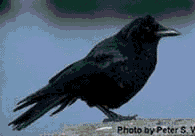| Wildlife
disease scientists from the USGS National Wildlife Health Center
(NWHC) are utilizing their specialized biological containment facilities
to provide diagnostic support and research results to Federal, State,
and local wildlife agencies, as well as to public health departments
that are utilizing dead wild birds as sentinels for detecting the
West Nile virus (WNV). Wild bird mortality
is an accurate indicator of the extent of WNV, and it continues
to provide an early warning system for the emergence of the virus
in new locations. The probable dissemination of the virus along
migratory corridors offers new challenges for both public health
and wildlife disease specialists.
 USGS
is working with the Centers for Disease Control and Prevention to
learn the current geographic extent of WNV, to understand how it
moves between birds, mosquitoes, and humans, and to predict future
movements of the virus. The 3-year study utilizes active wild bird
surveillance along the Atlantic Flyway, with simultaneous collection
of mosquitoes, to detect the presence of WNV. This system, based
on the ubiquitous presence of birds and their potential exposure
to disease, will indicate the diffusion of pathogens across eastern
America and provide a mechanism to detect novel pathogens in the
environment, determine their geographic extent, and identify their
relationship to the landscape and the environment. USGS
is working with the Centers for Disease Control and Prevention to
learn the current geographic extent of WNV, to understand how it
moves between birds, mosquitoes, and humans, and to predict future
movements of the virus. The 3-year study utilizes active wild bird
surveillance along the Atlantic Flyway, with simultaneous collection
of mosquitoes, to detect the presence of WNV. This system, based
on the ubiquitous presence of birds and their potential exposure
to disease, will indicate the diffusion of pathogens across eastern
America and provide a mechanism to detect novel pathogens in the
environment, determine their geographic extent, and identify their
relationship to the landscape and the environment.
Scientists in
the USGS Geographic Science Branch are providing the Centers for
Disease Control and Prevention, as well as public health agencies,
with real time geographic information on land-use and land-cover
data, roads, and hydrography in areas where the virus is active.
These data are being used by scientists in the field to identify
bird and mosquito habitat and to determine the best locations for
placement of mosquito traps.
Information
from the National West Nile Virus Surveillance System is being used
to compile and produce graphical displays and animations showing
the pattern and spread of the virus. An additional analysis is being
performed to detect clusters of infections and, possibly, the geographic
origin of the outbreak. Maps documenting West Nile virus activity
in 2001 are available through the Center for Integrated National
Disaster Information (CINDI).
The surveillance
system will provide basic information on the geography of WNV. The
combination of this data with information about landscape characteristics
and weather conditions, over space and time, will provide the foundation
for developing spatial analytical and forecasting models.
For more information
on the West Nile virus and to report sick or dead crows or other
unusual bird mortality, you can contact: Emi
Saito at 608-270-2456, Kathy
Converse at 608-270-2445, Bob
Dusek at 608-270-2403, or
Paul Slota at 608-270-2420, USGS, National Wildlife Health Center
or Dr. Stephen Guptill, USGS, Geographic Sciences Branch at 703-648-4520.
|

